Causes and Treatment Measures of Submarine Pipeline Free-Spanning
Abstract
1. Introduction
2. Causes of Submarine Pipeline Free-Spanning
2.1. Free-Spanning of Sea Pipelines Caused by Wave Current Scouring
2.2. Free-Spanning of Sea Pipe Caused by Other Reasons
2.2.1. Free-Spanning of Sea Pipe Caused by Seabed Relief
2.2.2. Free-Spanning of Sea Pipe Caused by Residual or Thermal Stress
2.2.3. Free-Spanning of Sea Pipe Caused by Human Activities
3. Treatment Methods of Submarine Pipeline Free-Spanning
3.1. Re-Digging and Burying
3.1.1. Jet Ditching Method
3.1.2. Mechanical Ditching Method
3.2. Structural Support Methods
3.2.1. Grouting Bag Support Method
3.2.2. Underwater Pile Support Method
3.2.3. Riprap Support Method
3.3. Covering Bionic Water Plant Method
3.4. Self-Embedding Choke Plate Method
3.5. Self-Buried Subsea Pipes Caused by Seabed Liquefaction
3.6. Other Governance Methods
3.7. Comparative Analysis of Various Governance Methods
- (1)
- For submarine pipelines with large free-span height and long free-span distance, adding support using the staggered arrangement of underwater piles can be considered first. If the free span is caused by the climbing of the pipeline and the soil on the hillside is soft, the height of the free span can first be reduced using blown mud to subsidize the sea pipe, and then treating it with the structural support method.
- (2)
- When laying pipelines on the seabed with large water flow speed and soft soil, bionic waterweed cover can be used to prevent pipeline erosion, or a baffle plate can be installed on the pipeline to promote the pipeline to self-bury.
- (3)
- For the free span of long length but small diameter pipelines, the trenches can be re-ditched or the ballasting method can be used for heavy objects;
- (4)
- For short-distance, free crossing pipelines in shallow waters, throw-filled crushed stone or grouting bag support can be used reasonably.
- (5)
- For the transition between the offshore platform riser and the submarine horizontal pipeline, a flexible hose crossover can be used.
- (6)
- For pipelines near offshore platforms, sandbags should be used to backfill all the spans of the pipeline, and then the pipelines should be covered with cement briquettes to improve the ability of the cover to resist erosion and external impact.
4. Conclusions
Author Contributions
Funding
Conflicts of Interest
References
- Ding, M.; Zhou, Y.G. On the ecological civilization dimension of human society development. Theor. Front. 2009, 23, 16–18. [Google Scholar]
- Zheng, Y.H.; Guo, H.D.; Wu, S.C. Analysis of China’s energy status and its development strategies. City 2018, 1, 35–42. [Google Scholar]
- Zhang, W.; He, N.X. Strategic analysis of offshore oil and gas resources development. Innov. Appl. Sci. Technol. 2016, 13, 122–126. [Google Scholar]
- Jin, W. L Analysis of submarine pipeline failure causes and countermeasures T7. Sci. Technol. Bull. 2004, 20, 529–533. [Google Scholar]
- Ba, J.B. Causes and prevention measures of submarine pipeline suspension. China New Technol. New Prod. 2013, 2, 64–65. [Google Scholar]
- Wilson, G. Free span threats. World Pipelines 2016, 16, 51–52. [Google Scholar]
- Ma, X.D. Analysis of free suspension span of submarine pipeline. Shanxi Archit. 2018, 44, 64–65. [Google Scholar]
- Dong, W.Y. Preventive Management of Suspended Section of Submarine Pipeline; Ocean Engineering Society of China: Taiyuan, China, 2011; pp. 431–439. [Google Scholar]
- Bartolini, L.; Crea, C.; Marchionni, L.; Vitali, L. Advanced Analysis and Design Tools for Offshore Pipeline in Operation. In Proceedings of the ASME 2011 30th International Conference on Ocean, Offshore and Arctic Engineering, Rotterdam, The Netherlands, 19–24 June 2011; Volume 4. [Google Scholar]
- Mork, K.; Verley, R.; Bruschi, R. Troll Oil Pipeline: Calibration of Safety Factors for Cross-Flow Vibrations of Spans on Very Uneven Seabed’s. In Proceedings of the International Conference on Offshore Mechanics and Arctic Engineering, Copenhagen, Denmark, 18–22 Jun 1995; pp. 439–447. [Google Scholar]
- Moshagen, H.; Verley, R.; Bruschi, R.; Solemsli, O. The Multi-span Project: Project Background and Summary. In Proceedings of the 16th International Conference on Offshore Mechanics and Arctic Engineering v.5:Pipeline Technology, Yokohama, Japan, 13–17 April 1997; pp. 1–6. [Google Scholar]
- Colicchio, G.; Mattioli, M.; Lugni, C.; Brocchini, M. Numerical investigation of the scouring around pipelines. In Proceedings of the 12th Numerical Towing Tank Symposium, Cortona, Italy, 4–6 October 2009; pp. 44–49. [Google Scholar]
- Herbich, J.B. Offshore Pipeline Design Elements; Marcel Dekker Inc.: New York, NY, USA, 1981. [Google Scholar]
- Demars, R.K. Measurement of Wave Induced Pressures and Stresses in a Sand bed. Mar. Geotechnol. 1983, 6, 29–59. [Google Scholar] [CrossRef]
- Liu, J.L. Evaluation of treatment methods for submarine pipeline scour and free suspension. In Proceedings of the 15th China Ocean (shore) Engineering Symposium (I) Ocean Engineering Society of China: Ocean Engineering Branch of Ocean Society of China, Taiyuan, China, 7–11 August 2011; p. 4. [Google Scholar]
- Zang, Z.; Cheng, L.; Zhao, M. A numerical model for onset of scour below offshore pipelines. Coast. Eng. 2009, 56, 458–466. [Google Scholar] [CrossRef]
- Sumer, B.M.; Truelsen, C.; Sichmann, T. Onset of scour below pipelines and self-burial. Coast. Eng. 2001, 42, 313–335. [Google Scholar] [CrossRef]
- Xia, L. Sediment Starting under Wave Action and Local Scouring Around Submarine Pipelines; Zhejiang University: Hangzhou, China, 2006. [Google Scholar]
- Zhen, Y. Effect of seepage flow on sediment incipient motion around a free spanning pipeline. Coast. Eng. 2019, 143, 50–62. [Google Scholar]
- Mattioli, M.; Mancinelli, A.; Colicchio, G.; Brocchini, M. Scouring below pipelines: The role of vorticity and turbulence. In Proceedings of the ASME Fluids Engineering Division Summer Conference 2010, Montreal, QC, Canada, 1–5 August 2010; Volume 2, pp. 265–267. [Google Scholar]
- Sumer, B.M.; Jensen, H.R.; Mao, Y. Effect of lee-wake on scour below pipelines in current. J. Waterw. Port Coast. Ocean Eng. 1998, 114, 599–614. [Google Scholar] [CrossRef]
- Jensen, B.L.; Sumer, B.M. Flow around and forces on a pipeline near a scoured bed in steady current arctic engineering. J. Offsh. Mech. Arct. Eng. 1990, 112, 206–213. [Google Scholar] [CrossRef]
- Sumer, B.M.; Fredsoe, J. Onset of scour below a pipeline exposed to waves. Int. J. Offsh. Polar Eng. 1991, 1, 189–194. [Google Scholar]
- Sumer, B.M.; Fredsoe, J. Wave scour around structures. Adv. Coast. Ocean Eng. 1997, 4, 191–248. [Google Scholar]
- Sumer, B.M. Scour around coastal structures: A summary of recent research. Coast. Eng. 2001, 44, 153–190. [Google Scholar] [CrossRef]
- Sumer, B.M.; Fredsoe, J. The Mechanics of Scour in the Marine Environment; World Scientific: Singapore, 2002. [Google Scholar]
- Chiew, Y.M. Mechanics of local scour around submarine pipeline. J. Hydraul. Eng. 1989, 116, 515–529. [Google Scholar] [CrossRef]
- Chiew, Y.M. Prediction of maximum scour depth at submarine pipelines. J. Hydraul Eng. 1991, 117, 452–466. [Google Scholar] [CrossRef]
- Brors, B. Numerical modelling of flow and scour at pipelines. J. Hydraul. Eng. 1999, 125, 511–523. [Google Scholar] [CrossRef]
- Smith, H.D.; Foster, D.L. Modelling of flow around a cylinder over a scoured bed. J. Waterw. Port Coast. Ocean Eng. 2005, 131, 14–24. [Google Scholar] [CrossRef]
- Myrhaug, D.; Rue, H. Scour below pipelines and vertical piles in random waves. Coast. Eng. 2003, 48, 227–242. [Google Scholar] [CrossRef]
- Kumar, A.; Neelamani, S.; Narasimha, S. Wave pressures and uplift forces on and scour around submarine pipeline in clayey soil. Ocean Eng. 2003, 30, 271–295. [Google Scholar] [CrossRef]
- Yan, T.; Li, P.; Li, G.X. Study on the scour stability of submarine pipelines in buried North Sea area. J. Qingdao Ocean Univ. 1999, 19, 721–726. [Google Scholar]
- Feng, X.X. Model of Silty Soil Response under Marine Hydrodynamic Conditions. Ph.D. Thesis, Qingdao Ocean University, Qingdao, China, 2000. [Google Scholar]
- Johnson, P.A. Reliability-based pier scour engineering. J. Hydraul. Eng. 1992, 118, 1344–1357. [Google Scholar] [CrossRef]
- Melville, B.W. Live-bed scour at bridge piers. J. Hydraul. Eng. 1984, 110, 1234–1247. [Google Scholar] [CrossRef]
- Sheppard, D.M.; Miller, W. Live-bed local pier scour experiments. J. Hydraul. Eng. 2006, 132, 635–642. [Google Scholar] [CrossRef]
- Dey, S.; Singh, N.P. Clear-water scour below underwater pipelines under steady flow. J. Hydraul. Eng. 2008, 134, 588–600. [Google Scholar] [CrossRef]
- Moncada-M, A.T.; Aguirre-Pe, J. Scour below pipeline in river crossings. J. Hydraul. Eng. 1999, 125, 953–958. [Google Scholar] [CrossRef]
- Dey, S.; Singh, N.P. Clear-water scour depth below under-water pipelines. J Hydro-Environ. Res. 2007, 1, 157–162. [Google Scholar] [CrossRef]
- Ibrahim, A.; Nalluri, C. Scour prediction around marine pipelines. In Proceedings of the International Conference on Offshore Mechanics and Arctic Engineering, New York, NY, USA, 3–6 November 1986; Volume 3, pp. 679–684. [Google Scholar]
- Mousavi, M.E.; Yeganeh-Bakhtiary, A.; Enshaei, N. The equivalent depth of wave-induced scour around offshore pipelines. J. Offshore Mech. Arct. Eng. 2009, 131, 021601. [Google Scholar] [CrossRef]
- Xu, J.; Li, G.; Dong, P.; Shi, J. Bedform evolution around a submarine pipeline and its effects on wave-induced forces under regular waves. Ocean Eng. 2010, 37, 304–313. [Google Scholar] [CrossRef]
- Mao, Y. The Interaction between a Pipeline and an Erodible Bed. Ph.D. Thesis, Institute of Hydrodynamics and Hydraulics Engineering, Technical University of Denmark, Lyngby, Denmark, 1986. [Google Scholar]
- Sumer, B.M. Scour below pipelines in waves. J. Waterw. Port Coast. Ocean Eng. 1990, 116, 307–323. [Google Scholar] [CrossRef]
- Mattioli, M.; Alsina, J.M.; Mancinelli, A.; Miozzi, M.; Brocchini, M. Experimental investigation of the nearbed dynamics around a submarine pipeline laying on different types of seabed: The interaction between turbulent structures and particles. Adv. Water Res. 2012, 48, 31–46. [Google Scholar] [CrossRef]
- Mattioli, M.; Mancinelli, A.; Brocchini, M. Experimental investigation of the wave-induced flow around a surface-touching cylinder. J. Fluids Struct. 2013, 37, 62–87. [Google Scholar] [CrossRef]
- Cheng, L.; Li, F. Modeling of local scour below a sagging pipeline. Coast. Eng. 2003, 45, 189–210. [Google Scholar] [CrossRef]
- Li, F.J.; Liang, C. Numerical model for local scour under offshore pipeline. J. Hydraul. Eng. 1999, 125, 400–406. [Google Scholar] [CrossRef]
- Postacchini, P.; Brocchini, M. Scour depth under pipelines placed on weakly cohesive soils. Appl. Ocean Res. 2015, 52, 73–79. [Google Scholar] [CrossRef]
- Hansen, E.A.; Fredsøe, J.; Ye, M. Two-dimensional scour below pipelines. In International Offshore Mechanics and Arctic Engineering. Symposium. 5; ASME: New York, NY, USA, 1986; pp. 670–678. [Google Scholar]
- Kjeldsen, S.P.; Gjørsvik, O.; Bringaker, K.G.; Jacobsen, J. Local scour near offshore pipelines. In Proceedings of the 2nd International Conference on Port and Ocean Engineering under Arctic Conditions, University of Iceland, Reykjavik, Iceland, 27–30 August 1973; pp. 308–331. [Google Scholar]
- Maza, J.A. Introduction to River Engineering, Advanced Course on Water Resources Management; Universita ´Italiana per Stranieri: Perugia, Italy, 1987. [Google Scholar]
- Myrhaug, D.; Ong, M.C.; Føien, H.; Gjengedal, C.; Leira, B.J. Scour below pipelines and around vertical piles due to second-order random waves plus a current. Ocean Eng. 2009, 36, 605–616. [Google Scholar] [CrossRef]
- Azamathulla, H.M.D.; Guven, A.; Demir, Y.K. Linear genetic programming to scour below submerged pipeline. Ocean Eng. 2011, 38, 995–1000. [Google Scholar] [CrossRef]
- Azamathulla, H.M.D.; Zakaria, N.A. Prediction of scour below submerged pipeline crossing a river using ANN. IWA Water Sci. Technol. 2011, 63, 2225–2230. [Google Scholar] [CrossRef]
- Etemad-Shahidi, A.; Yasa, R.; Kazeminezhad, M.H. Prediction of wave-induced scour depth under submarine pipelines using machine learning approach. Appl. Ocean Res. 2011, 33, 54–59. [Google Scholar] [CrossRef]
- Najafzadeh, M.; Gholam-Abbas, B. Prediction of pipeline scour depth in clear-water and live-bed conditions using group method of data handling. Neural Comput. Appl. 2014, 24, 629–635. [Google Scholar] [CrossRef]
- Bijker, R.; Staub, C.; Bruschi, R.; Silvis, F. Scour-induced Free Spans. In Proceedings of the Offshore Technology Conference, Houston, TX, USA, 6–9 May 1991. [Google Scholar]
- Sumer, B.M.; Fredsøe, J. A Review of Wave/Current-Induced Scour Around Pipelines Coastal Engineering. In Proceedings of the 23rd International Conference on Coastal Engineering, Venice, Italy, 4–9 October 1992. [Google Scholar]
- Drago, M.; Mattioli, M.; Bruschi, R.; Vitali, L. Insights on the design of free-spanning pipelines. Philos. Trans. R. Soc. A Math. Phys. Eng. Sci. 2015, 373, 20140111. [Google Scholar] [CrossRef] [PubMed]
- Zhou, C.; Li, G.; Dong, P. An experimental study of seabed responses around a marine pipeline under wave and current conditions. Ocean Eng. 2011, 38, 226–234. [Google Scholar] [CrossRef]
- Zhang, J.; Sun, G.M.; Wang, L.Q. Study on scour start of submarine pipeline under the combined action of wave and current. Port Eng. Technol. 2017, 54, 23–27. [Google Scholar]
- Cai, C.L.; Zhang, Y.B.; Hu, B. Factors influencing the scour effect of seabed pipeline in East China Sea. Offshore Pet. 2013, 33, 96–100. [Google Scholar]
- Liu, D.J.; Huang, P.Y.; Hu, T.J. Influencing factors of seabed oil pipeline scour in zhoushan shidao Zhuhai, ningbo. Front. Mar. Geol. 2014, 30, 39–44. [Google Scholar]
- Zang, Z.P. Research on the equilibrium depth and time scale of submarine pipeline scour under the action of oblique current. In Proceedings of the 18th China Ocean (Shore) Engineering Symposium (II), Ocean Engineering Society of China, Zhoushan, China, September 2017. [Google Scholar]
- Liu, Y.Y.; Lv, L.; Zheng, M.Z. Analysis of seabed stability and local scour of submarine pipeline under wave flow. J. Zhejiang Univ. 2012, 46, 1135–1142. [Google Scholar]
- Feng, H.; Wang, Y.H.; Wang, J. Treatment of submarine pipeline suspension span and its applicability analysis. China Shipbuild. Ind. 2012, 53, 74–81. [Google Scholar]
- Pan, X.G. Causes and prevention of submarine pipeline suspension. China Ship Insp. 2005, 10, 68–69. [Google Scholar]
- Wen, S.P.; Xu, J.S.; Hu, G.H. A field investigation on the effects of background erosion on the free span development of a submarine pipeline. J. Ocean Univ. China 2015, 14, 621–628. [Google Scholar] [CrossRef]
- Fyrileiv, O. Update design procedure for free spanning pipelines DNV-RP-F105: Multi-mode response. In Proceedings of the International Conference on Offshore Mechanics & Arctic Engineering, Hamburg, Germany, 4–9 June 2006; pp. 57–64. [Google Scholar]
- Zhao, D.; Li, X.F.; Feng, X.H. Analysis of submarine pipeline unevenness. Ship Sci. Technol. 2014, 36, 112–116. [Google Scholar]
- Xie, Y.; Ma, X.F.; Ning, H.F. Formation and failure mechanism of submarine suspension pipeline. Oil Gas Storage Transp. 2017, 36, 1436–1442. [Google Scholar]
- Zuo, R. Study on the suspended transverse-vortex-induced vibration response of deep-water submarine pipeline. Electron. Fabr. 2013, 4, 183–188. [Google Scholar]
- Xu, J.; Shi, Z.D.; Zhang, K. Analysis and study on fatigue life of suspended submarine pipeline. Offshore Pet. 2009, 29, 80–84. [Google Scholar]
- Shao, W.C.; Xia, X.X. Submarine pipeline embedding machine and its application. Zhejiang Water Conserv. Sci. Technol. 2005, 3, 41–43. [Google Scholar]
- Wang, L.; Xing, P.; Wang, Y.Z. Design of Plough for Submarine Free Span Pipeline Laying. Oil Field Equip. 2013, 42, 14–17. [Google Scholar]
- Li, S.G. Research on Floating Towpipe Technology in Intertidal Waters. Master’s Thesis, Tianjin University, Tianjin, China, 2007. [Google Scholar]
- Grinsted, T.W.; Reece, A.R. Pipeline or Cable Plough. U.S. Patent 4,802,793, 7 February 1989. [Google Scholar]
- Zhang, G.G. Introduction of world-renowned underwater trenching machinery design and construction company and machine type. Ocean Technol. 1990, 2, 5–64. [Google Scholar]
- Zhang, G.G. Trench plough for submarine pipeline and its design analysis. Oil Gas Storage Transp. 1989, 2, 32–38. [Google Scholar]
- Kang, L.S. Method and equipment for trench excavation and burial of submarine pipeline. Ocean Eng. 1992, 10, 10–18. [Google Scholar]
- Gong, H.Y.; Wang, L.Q.; Xing, X.D. Plough body modeling and soil cracking of subsea plough trench-digger. J. Mech. Eng. 2012, 48, 135–140. [Google Scholar]
- Guo, Z.H.; Zhou, D.Y.; Zhou, Z.L. Simulation study on mechanical properties of tillage components with different soil contact surfaces. Chin. J. Mech. Eng. 2010, 46, 71–75. [Google Scholar] [CrossRef]
- Chen, C.Y.; Chen, L.G.; Wang, X.Z. Parameter design of double-wing tilling plough. Chin. J. Agric. Mach. 2000, 31, 27–29. [Google Scholar]
- Brown, R.; Palmer, A. Submarine pipeline trenching by multipass ploughs. In Proceedings of the Offshore Technology Conference, Houston, TX, USA, 6–9 May 1985. [Google Scholar]
- Voldsund, T.A. Modelling and Control of Offshore Ploughing Operations. Master’s Thesis, Norwegian University of Science and Technology, Trondheim, Norway, 2007. [Google Scholar]
- Hydrovision, S.M.D. Introduction to SMD Hydrovision; SMD Hydrovision, Place Published: Newcastle upon Tyne, UK, 2004. [Google Scholar]
- Lauder, K.D. Variation of tow force with velocity during offshore ploughing in granular materials. Can. Geotech. J. 2012, 49, 1244–1255. [Google Scholar] [CrossRef]
- CTC. Datasheet-APP-REV02LH EB/OLD.2019. Available online: http://www.ctcmarine.com/page/520/ Trenchers Ploughs# 9900476 (accessed on 1 May 2019).
- Cathie, D. Pipeline and Cable Plough Stability in Soft Clays. In Proceedings of the Offshore Site Investigation and Geotechnics: Confronting New Challenges and Sharing Knowledge, London, UK, 11–13 September 2007. [Google Scholar]
- Vessel & ROV News. SMD Hydrovision Unveils AMP500 Plough [EB/OL]. Available online: http://www.oilpubs.com/ oso/article.asp?v1=1134 (accessed on 1 May 2019).
- CTC Marine Projects. VMP Technical Specification [EB/OL]. Available online: http://www.ctcmarine.com (accessed on 1 May 2019).
- Tang, X.X.; Hu, G.H. Comprehensive treatment of suspended span of submarine oil pipeline. Oil Gas Field Surf. Eng. 2011, 30, 38–39. [Google Scholar]
- Wang, Z.; Hu, C.Y. Research on Grouting Bag Laying Device for Suspended Span Treatment of Submarine Pipeline; Harbin University of Engineering: Harbin, China, 2016. [Google Scholar]
- Song, C.N.; Zhang, Y.T.; Miao, C.S. Treatment Method of Submarine Pipeline Suspension Span. CN106015736A, 12 October 2016. [Google Scholar]
- Ye, H.B.; Song, C.N.; Cui, N. Principle and construction technology of cantilever beam support method. Oil Gas Storage Transp. 2014, 33, 86–88. [Google Scholar]
- Ma, K.M. Application of structural support design in submarine pipeline suspension governance. Pet. Chem. Equip. 2017, 20, 47–50. [Google Scholar]
- Ni, Z.Z.; Liu, G.; Yuan, Z.H. Study on treatment methods of offshore suspended span of submarine pipeline. Chem. Eng. Equip. 2017, 10, 99–100. [Google Scholar]
- Chamizo, D.J.; Campbell, D.R.; Jas, E.P. Rock Berm Design for Pipeline Stability. In Proceedings of the ASME 2012 31st International Conference of Ocean, Offshore and Arctic Engineering, Rio de Janeiro, Brazil, 1–6 July 2012. [Google Scholar]
- CIRIA. The Rock Manual—The Use of Rock in Hydraulic Engineering, 2nd ed.; C683; CIRIA: London, UK, 2007; ISBN 978-0-86017-683. [Google Scholar]
- Hinwood, J.B.; Lipski, W. Failure Modes of Rock Berms for Offshore Pipeline Protection. In Proceedings of the International Society of Offshore and Polar Engineers, Kitakyushu, Japan, 26–31 May 2002; pp. 32–37. [Google Scholar]
- Olso, E.; Nyhus, B.; OStby, E. Assessment of Fracture Integrity for Trawl Impact of the Ormen Lange SFD Pipelines. In Proceedings of the ASME International Conference on Ocean, Honolulu, HI, USA, 31 May–5 June 2009; pp. 841–850. [Google Scholar]
- Sun, Q.; Yu, C.L.; Feng, X.W. Research and application of partial ripping stone for suspension span treatment of deepwater submarine pipelines. Pet. Eng. Constr. 2016, 42, 14–19. [Google Scholar]
- Song, D.J. Analysis of reasons and countermeasures for the suspension of submarine pipeline lying. Digit. Commun. World 2017, 10, 84–89. [Google Scholar]
- Liu, J.K.; Zhang, Z.F. Application of bionic water plant in suspension protection of submarine pipeline. Pet. Eng. Constr. 2009, 35, 20–22. [Google Scholar]
- Liu, J.K.; Zhang, Z.F. Application of bionic scour prevention system in chengdao oilfield. China Offshore Platf. 2008, 23, 36–38. [Google Scholar]
- Li, Y.H.; Yu, G.L. Experimental Study on Angle of Slant of Flexible Permeability Promoting Silt Floating Curtain. J. Shanghai Jiaotong Univ. 2009, 3, 169–172. [Google Scholar]
- Li, Y.H.; Chen, Q.Q.; Yu, G.L. Research progress and prospect of silt promotion and anti-erosion technology on beach. Coast. Eng. 2007, 4, 27–34. [Google Scholar]
- Cheng, L.; Chew, L.W. Modelling of flow around a near-bed pipeline with a spoiler. Oceaning 2003, 30, 1595–1611. [Google Scholar] [CrossRef]
- Hulsbergen, C.H. Spoilers for stimulated self-Burial of submarine pipelines. In Proceedings of the Offshore Technology Conference, Houston, TX, USA, 5–8 May 1984; pp. 441–444. [Google Scholar]
- Hulsbergen, C.H.; Bijker, R. Effect of spoilers on submarine pipeline stability. In Proceedings of the Offshore Technology Conference, Houston, TX, USA, 1–4 May 1989; pp. 337–350. [Google Scholar]
- Gokce, K.T.; Gunbak, A.R. Self-burial and stimulated self-burial of pipelines by waves. In Proceedings of the 1st International Conference on Offshore and Polar Engineering II, Edinburgh, UK, 11–16 August 1991; pp. 301–307. [Google Scholar]
- Yang, L.P. Research on Submarine Pipeline Scour and Protection under Wave Action; Ocean university of China: Qingdao, China, 2012. [Google Scholar]
- Han, Y. Comparative experimental study on protection of submarine pipeline by rigid choke plate and flexible guide plate. In Proceedings of the China Branch of International Water Engineering and Research Association: China Hydraulic Power Engineering Society, Xi’an, China, September 2009. [Google Scholar]
- Zhang, Z.Y.; Ruan, X.J. Research on the influence of diversion deflector on the submarine pipeline under the action of waves. Ocean Eng. 2012, 30, 90–96. [Google Scholar]
- Chiew, Y.M. Effect of spoilers on scour at submarine pipelines. J. Hydraul. Eng. 1992, 118, 1311–1317. [Google Scholar] [CrossRef]
- Chiew, Y.M. Effect of spoilers on wave-induced scour at submarine pipelines. J. Waterw. Port Coast. Ocean Eng. 1993, 119, 417–429. [Google Scholar] [CrossRef]
- Jiang, W.Q.; Jiang, H.J.; Yang, F. Influence of diversion plate on submarine pipeline sinking and self-burying and vortex vibration. J. China Univ. Pet. 2018, 42, 147–152. [Google Scholar]
- Lai, H.; Ye, Y.C.; Wei, Y.J. A preliminary study on the evolution process of scour and self-burial of submarine pipelines in hangzhou bay. Oceanography 2011, 29, 65–71. [Google Scholar]
- Castro, G. Liquefaction of Sands; Harvard Soil Mechanics Series No.81.1969; Harvard University: Cambridge, MA, USA, 1969. [Google Scholar]
- Kramer, S.L. Triggering liquefaction flow slides in coastal soil deposits. Eng. Geol. 1988, 26, 17–31. [Google Scholar] [CrossRef]
- Kramer, S.L.; Seed, H.B. Initiation of soil liquefaction under static loading conditions. J. Geotech. Eng. 1988, 114, 412–430. [Google Scholar] [CrossRef]
- Boulanger, R.W.; Idriss, I.M. Liquefaction susceptibility criteria for silts and clays. J. Geotech. Geoenviron. Eng. 2006, 132, 1413–1426. [Google Scholar] [CrossRef]
- Bray, D.J.; Sancio, R.B. Assessment of the liquefaction susceptibility of fine-grained soils. J. Geotech. Geoenviron. Eng. 2006, 132, 1165–1177. [Google Scholar] [CrossRef]
- Muhunthan, B.; Worthen, D.L. Critical state framework for liquefaction of fine grained soils. Eng. Geol. 2011, 117, 2–11. [Google Scholar] [CrossRef]
- Seed, H.B.; Idriss, I.M. Ground Motions and Soil Liquefaction during Earthquakes; Technical Report; Earthquake Engineering Research Institute: Berkerlay, CA, USA, 1979. [Google Scholar]
- Okusa, S. Wave-induced stress in unsaturated submarine sediments. Geotechnique 1985, 35, 517–532. [Google Scholar] [CrossRef]
- Tsai, C.P. Wave-induced liquefaction potential in a porous seabed in front of a breakwater. Ocean Eng. 1995, 22, 1–18. [Google Scholar] [CrossRef]
- Zen, K.; Yamazaki, H. Oscillatory pore pressure and liquefaction in seabed induced by ocean waves. Soils Found. 1990, 30, 147–161. [Google Scholar] [CrossRef]
- Jeng, D.-S. Wave-Induced Seabed Response in Front of a Breakwater. Ph.D. Thesis, University of Western Australia, Perth, Australia, 1997. [Google Scholar]
- Nataraja, M.S.; Gill, H.S. Ocean wave-induced liquefaction analysis. J. Geotech. Eng. 1983, 109, 573–590. [Google Scholar] [CrossRef]
- Ishihara, K. Liquefaction and flow failure during earthquakes. Geotechnique 1993, 43, 349–416. [Google Scholar] [CrossRef]
- Liu, Z.F. Governance of suspended span section of submarine pipeline in ledong gas field. In Proceedings of the 2009 Academic Conference on Ocean Engineering (Part II), Xiamen, China, November 2009. [Google Scholar]
- Lin, S.Q.; Ye, Y.B.; Qi, B.B. Research on treatment method of suspended span of sea pipe based on jet flow. Mech. Eng. 2018, 5, 170–172. [Google Scholar]
- Yun, D. History Effects for Deepwater S-Lay of Pipelines. In Proceedings of the ASME International Conference on Offshore Mechanics & Arctic Engineering, Cancun, Mexico, 8–13 June 2003; Volume 126, pp. 833–841. [Google Scholar]
- Summer, L.; Yang, H.; Deng, H.X. Analysis of submarine pipeline suspension span and recommended practice of unequal seabed treatment. China Shipbuild. 2008, 49, 523–528. [Google Scholar]
- Bruschi, R.; Drago, M.; Bughi, S.; Gianfelici, F. In-place stability and integrity of offshore pipelines crossing or resting on active bedforms or loose or soft soils. J. Pipeline Eng. 2014, 13, 167–199. [Google Scholar]
- She, W.W. Research on the Mechanism of Ecological Silt Promotion and Scour Prevention Near the Underwater Pipeline; Shanghai Jiaotong University: Shanghai, China, 2010. [Google Scholar]
- Yu, G.L.; Chen, Q.Q.; Li, Y.H. Development status and trend of anti-scour protection technology for submarine pipelines. Water Resour. Hydropower Technol. 2007, 11, 30–33. [Google Scholar]

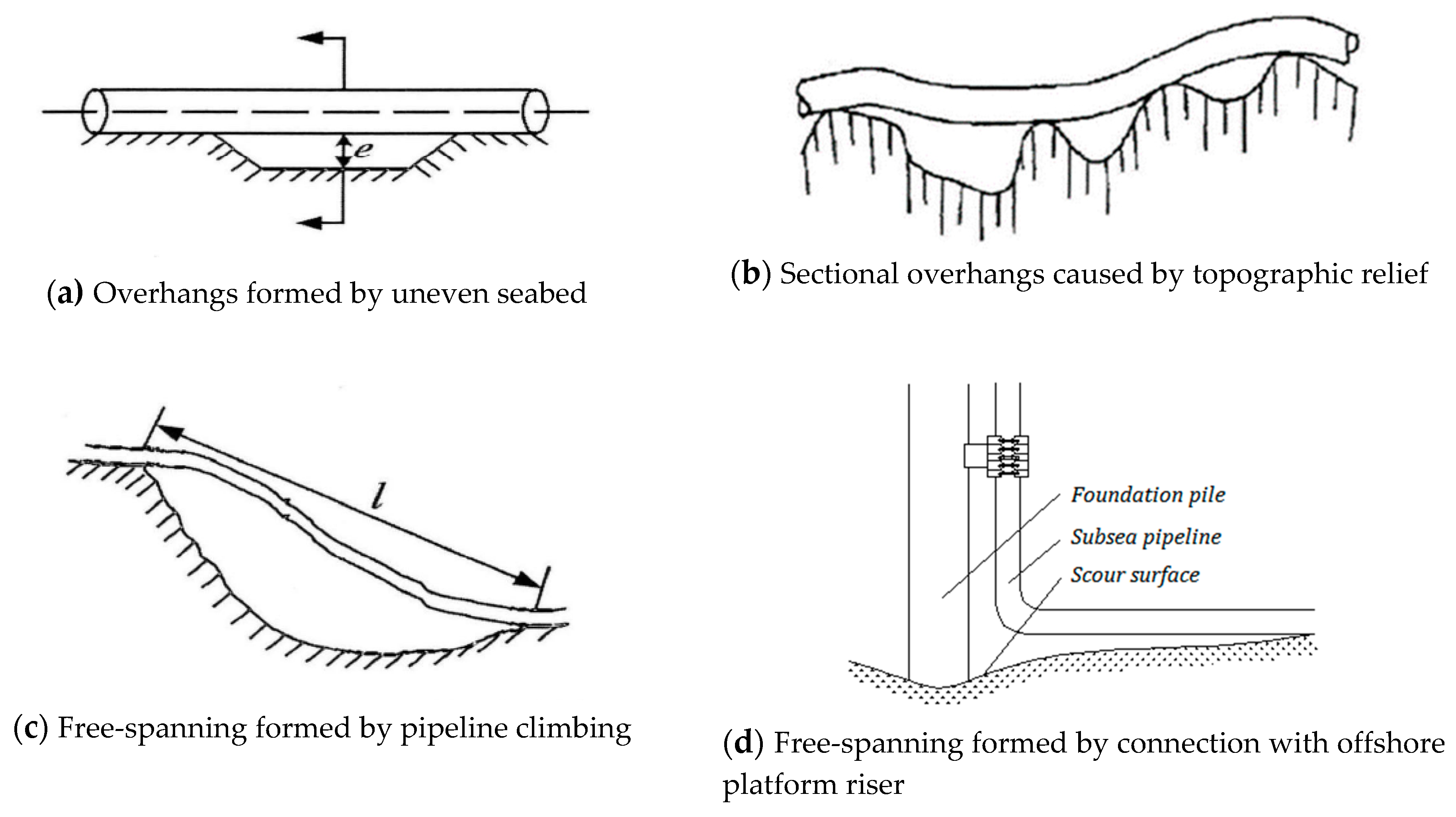
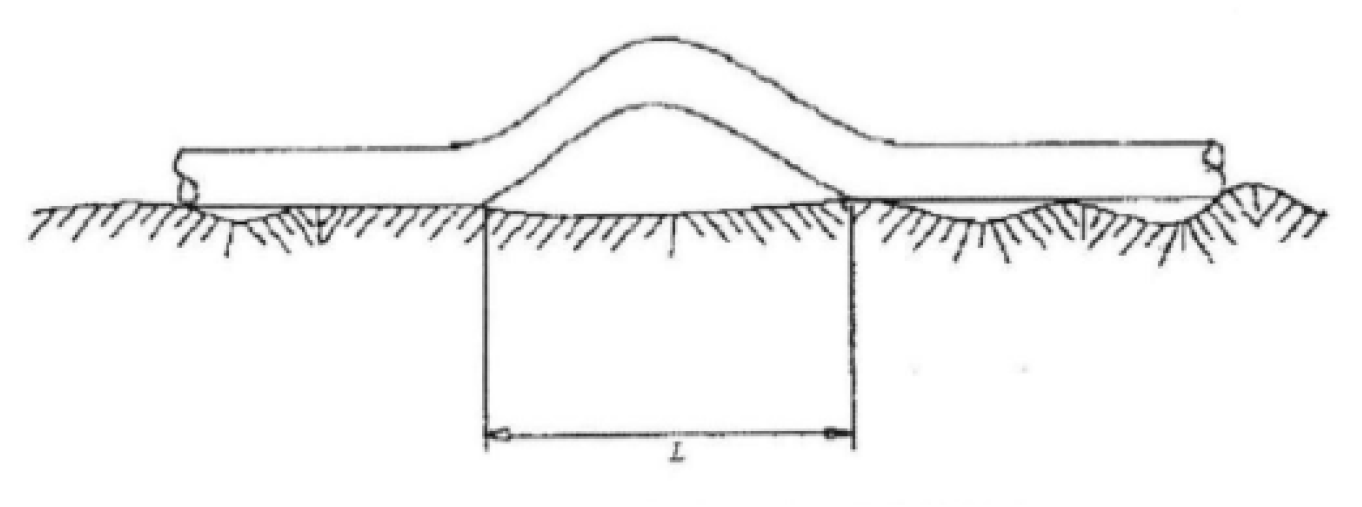
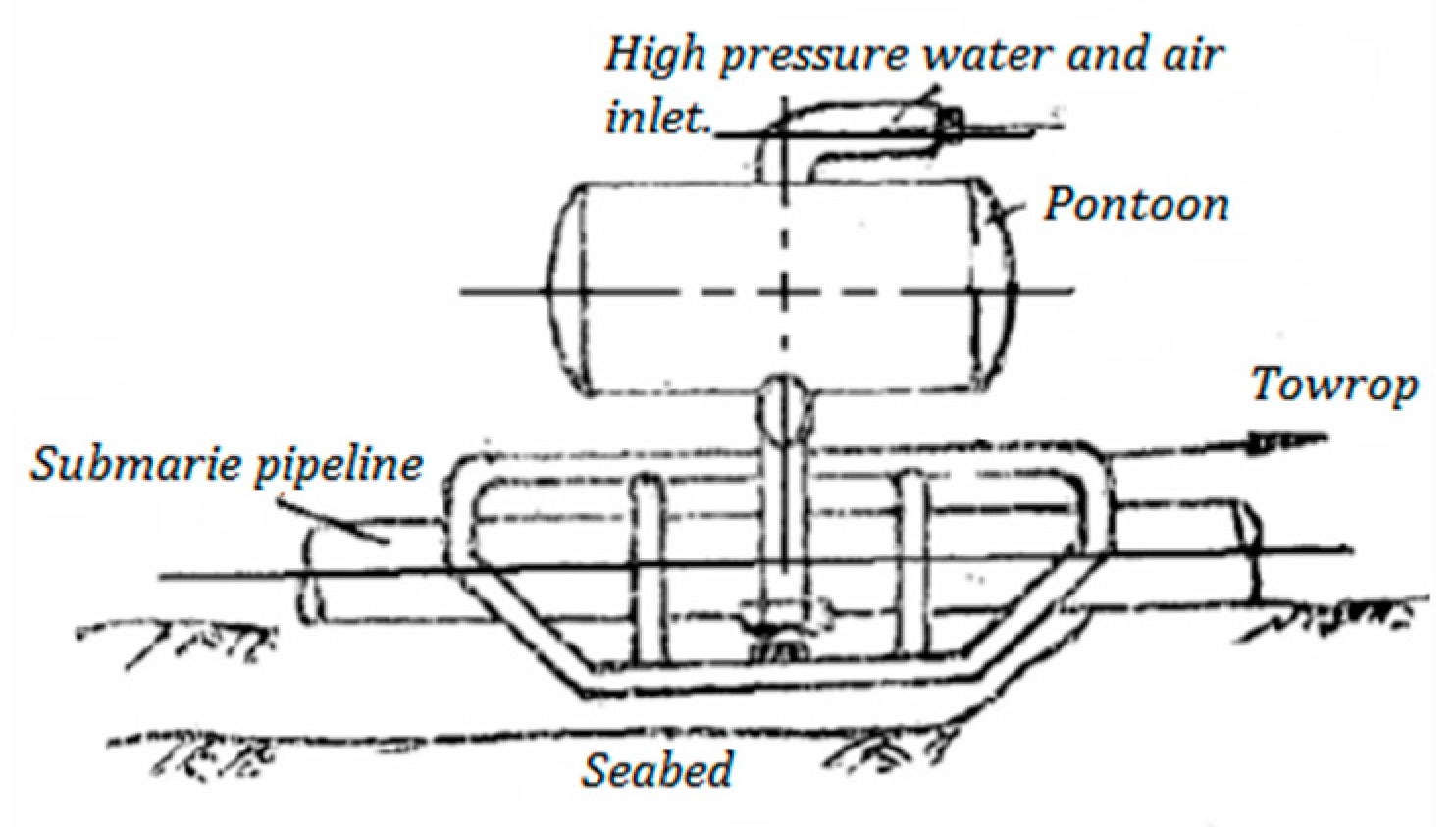
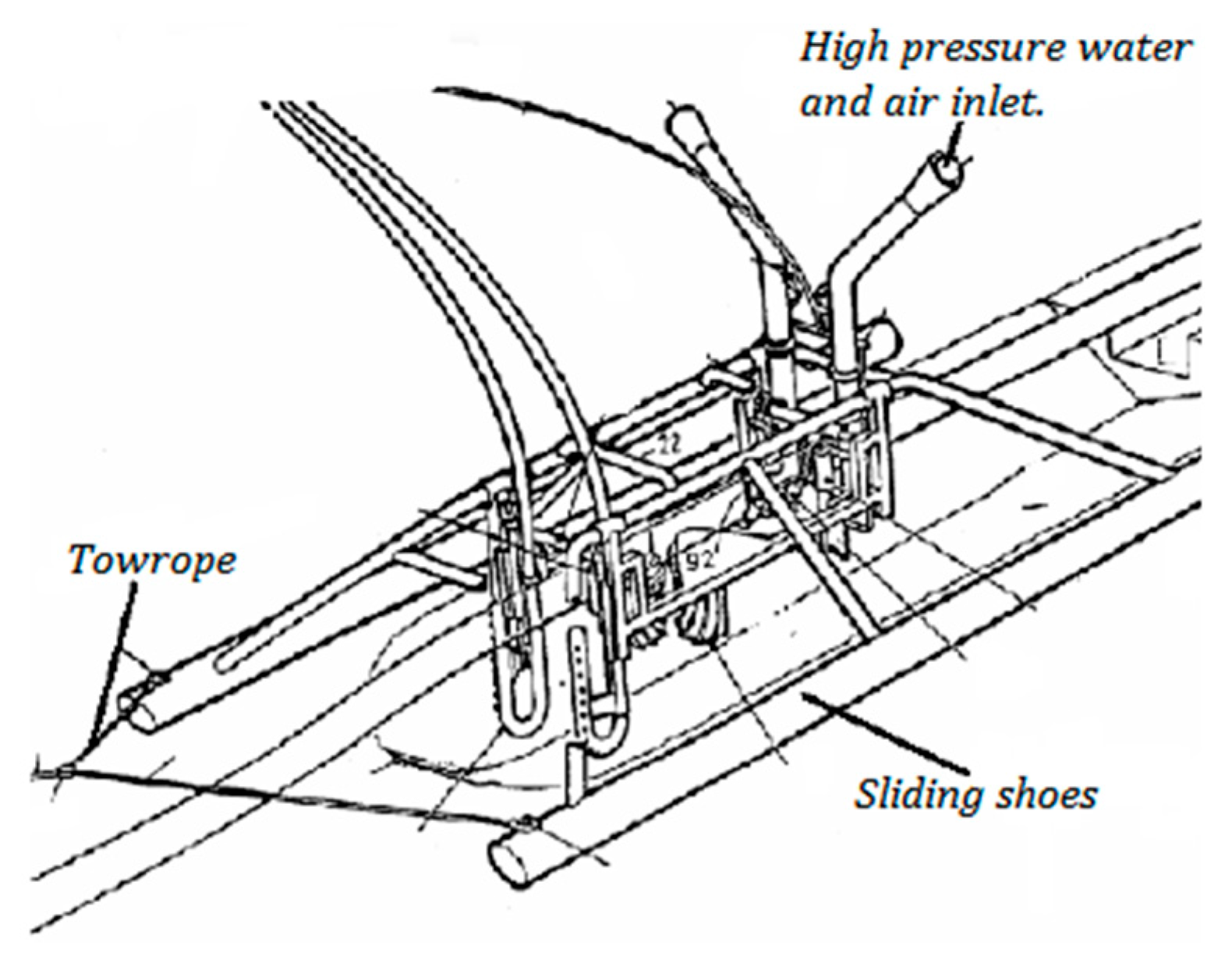

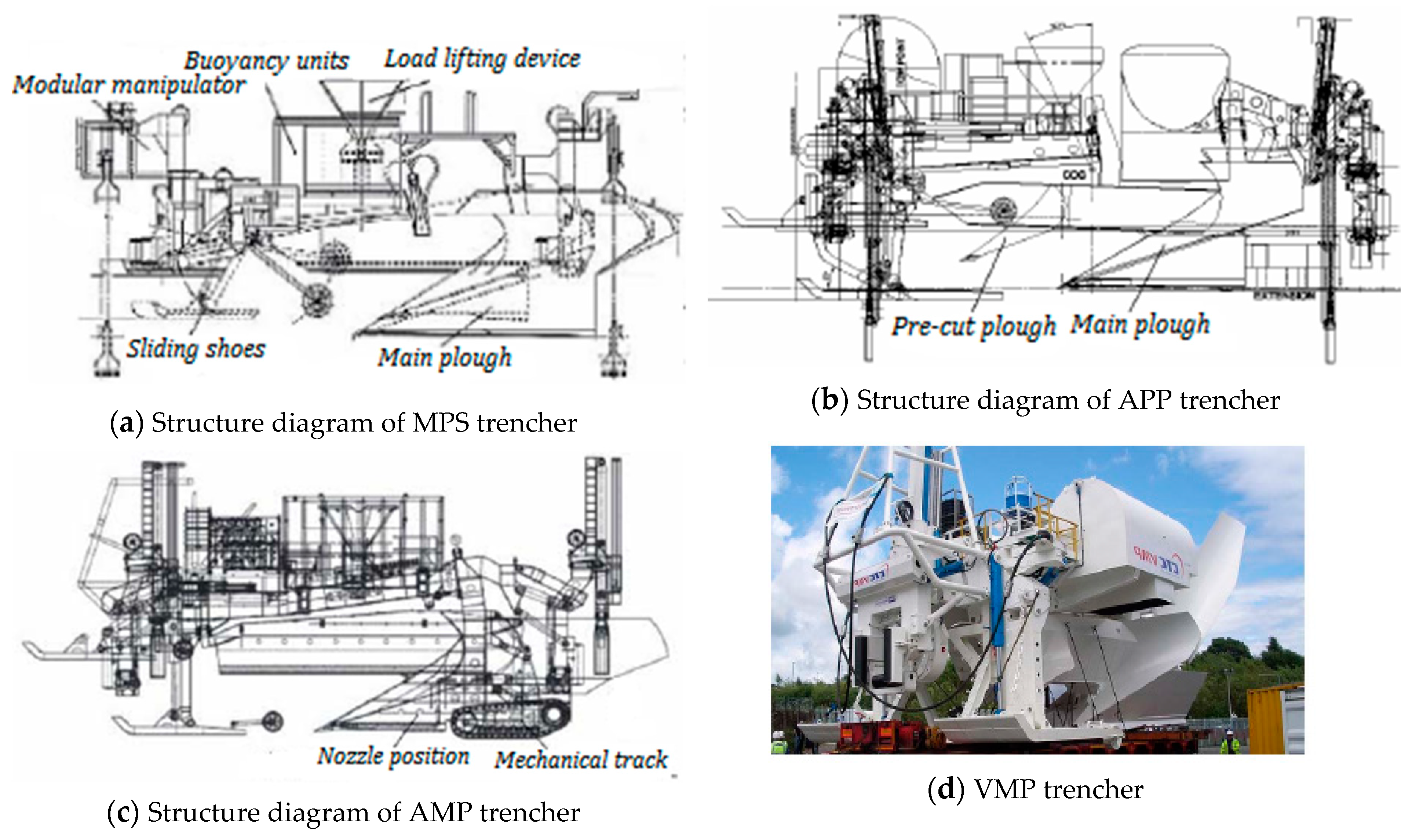
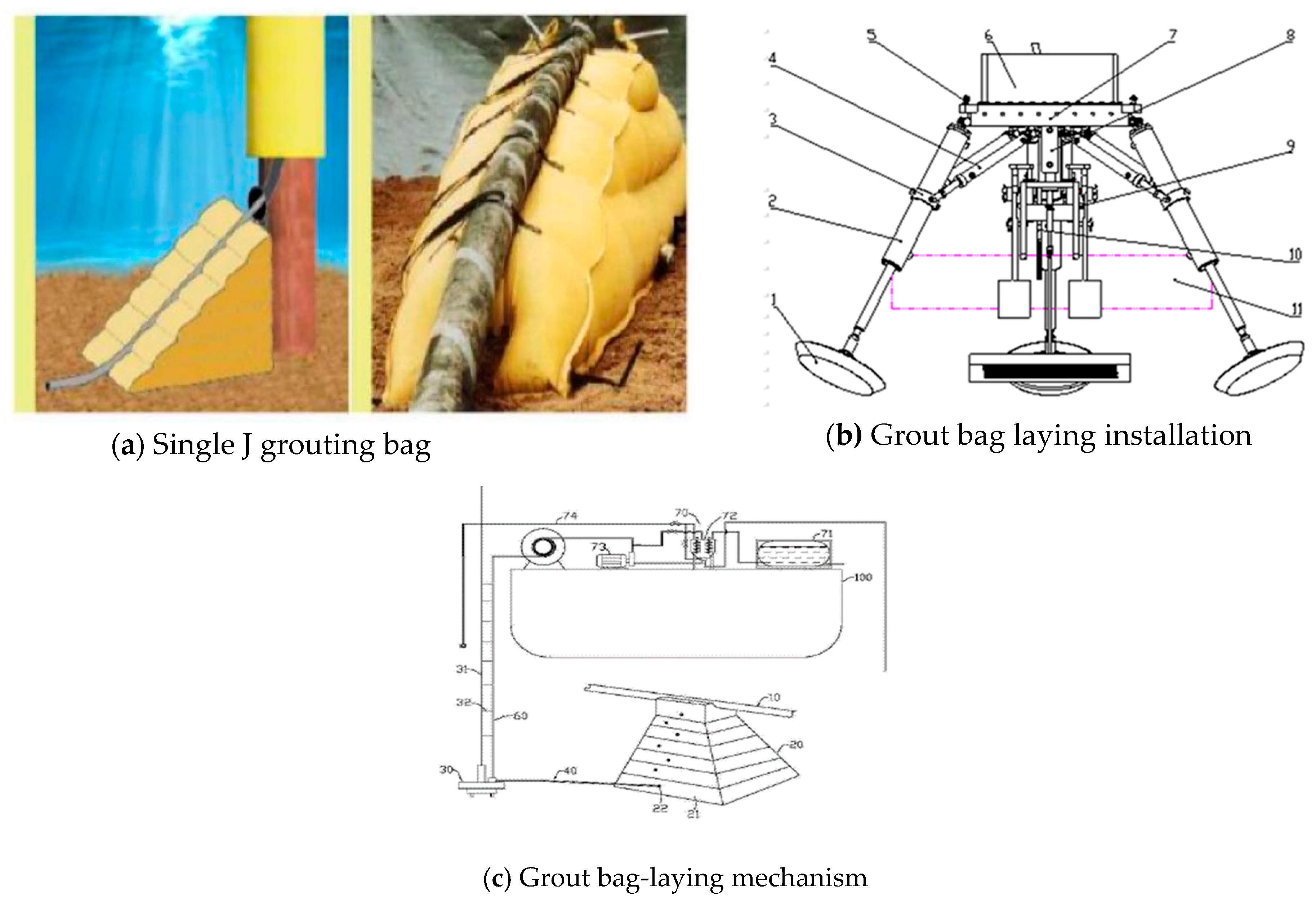
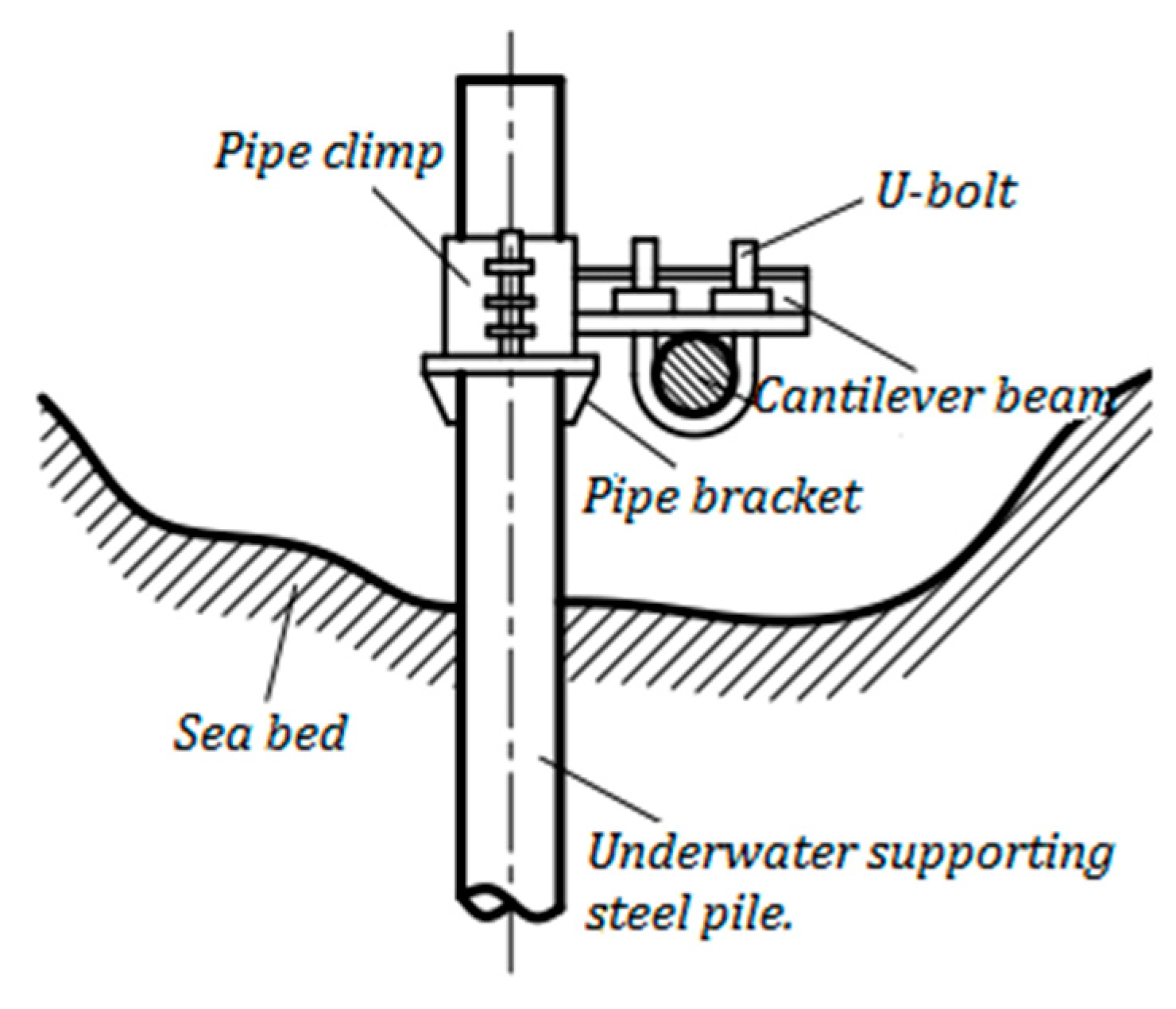
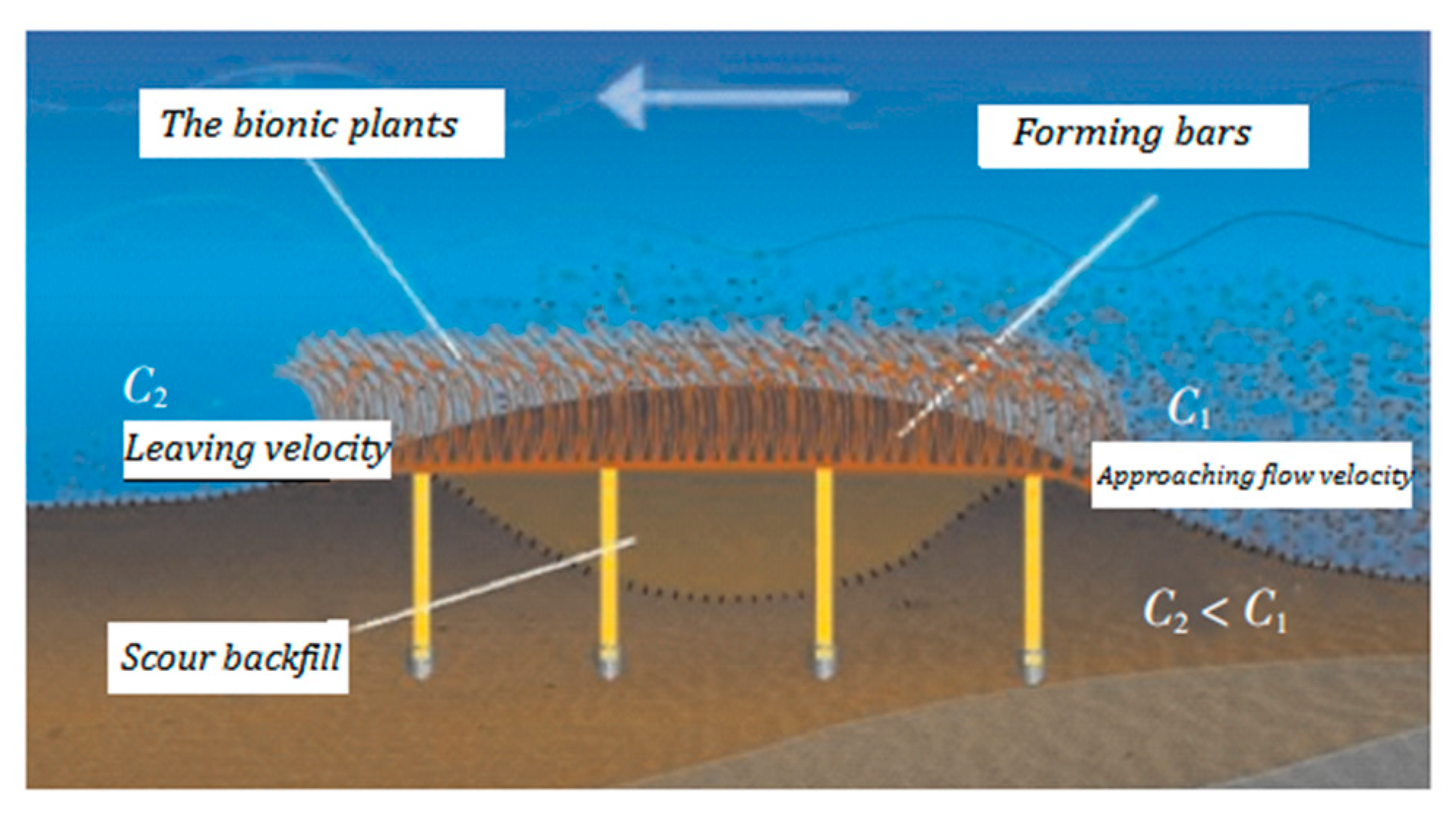
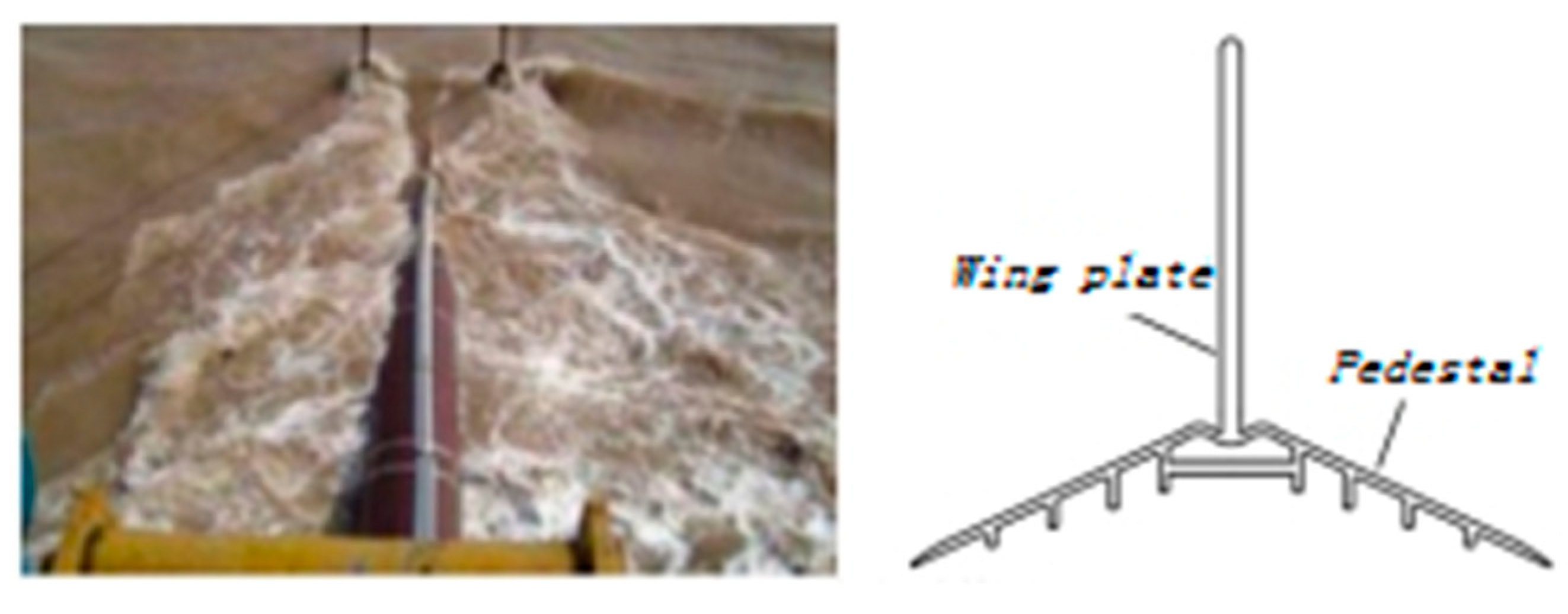
| Year | Place | Reason | Consequence |
|---|---|---|---|
| 1964–1965 | U.S. offshore water pipelines | Impact of Hurricane Betsy | Pipelines moved |
| 1996 | U.S. offshore water pipelines | Impact of Hurricane Flossy | Non-buried pipelines moves |
| 1997 | The Zeepipe IIA pipelines in the Norwegian sector of the North Sea | Wave scouring | Exceeding the maximum span, threatening security operations |
| 2001 | Daixi landing pipelines | Scouring leads to insufficient depth | Ship drag anchor damage |
| 2002 | Yubei Oilfield | Wave scouring | Pipe fatigue fracture |
| 2003–2009 | Chengdao Oilfield | Wave scouring | Pipe rupture, causing oil and gas leaks |
| 2009 | Ledong gas field | Pipelines climbing and scouring | Exceeding the maximum span, threatening security operations |
| 2010 | Huizhou Natural Gas Submarine Pipelines | Scouring | Pipe fatigue cracking |
| Management Plan | Advantages | Disadvantages |
|---|---|---|
| Ditching plow method | Applicable to seabeds of various soil types, with low requirements on operating sea conditions | Required traction is large, the pipeline crossing other sea pipe or cable cannot be used, the cost is high |
| Jet ditching method | Suitable for soft seabed, small traction required | Efficiency of trenching on hard seabed is low; when water depth is over 100 m, wave current and sea current actions on water pipe or air hose may cause instability of trencher foundation |
| Grouting bag support method | Construction is simple, management cost is low, the implementation does not need the pipeline to stop production | Long-term erosion of the wave current may cause the grouting bag to sink and lose support to the pipe |
| Underwater pile bracing | Can be adapted to undulating seabed terrain and handle high free-spanning pipelines | High cost, small protection range, support pile, as a new structure, may cause secondary erosion |
| Ripped-rock method | Simple construction, easy access to raw materials, and can handle a wide range of free-spanning | When the water is deeper, a riprap guiding device should be used |
| Bionic water plant method | Prevents pipeline erosion, promotes sedimentation, good treatment effect, no secondary erosion | High cost, time consuming, and cannot be used as a free-spanning emergency treatment measure |
| Spoiler self-buried method | Easy installation, no need for offshore operation | Not suitable for rock and clay seabed |
| Flexible hose bonding method | Flexible, can change with the seabed topography and effectively resist fatigue damage | The hose should be redesigned according to the scoured terrain, and the pipeline must be shut down during implementation |
| Heavy ballast method | Simple construction, high economic benefits | Only applicable to the free-spanning height of a few centimeters or so |
© 2020 by the authors. Licensee MDPI, Basel, Switzerland. This article is an open access article distributed under the terms and conditions of the Creative Commons Attribution (CC BY) license (http://creativecommons.org/licenses/by/4.0/).
Share and Cite
Zhang, B.; Gong, R.; Wang, T.; Wang, Z. Causes and Treatment Measures of Submarine Pipeline Free-Spanning. J. Mar. Sci. Eng. 2020, 8, 329. https://doi.org/10.3390/jmse8050329
Zhang B, Gong R, Wang T, Wang Z. Causes and Treatment Measures of Submarine Pipeline Free-Spanning. Journal of Marine Science and Engineering. 2020; 8(5):329. https://doi.org/10.3390/jmse8050329
Chicago/Turabian StyleZhang, Bo, Rui Gong, Tao Wang, and Zhuo Wang. 2020. "Causes and Treatment Measures of Submarine Pipeline Free-Spanning" Journal of Marine Science and Engineering 8, no. 5: 329. https://doi.org/10.3390/jmse8050329
APA StyleZhang, B., Gong, R., Wang, T., & Wang, Z. (2020). Causes and Treatment Measures of Submarine Pipeline Free-Spanning. Journal of Marine Science and Engineering, 8(5), 329. https://doi.org/10.3390/jmse8050329




